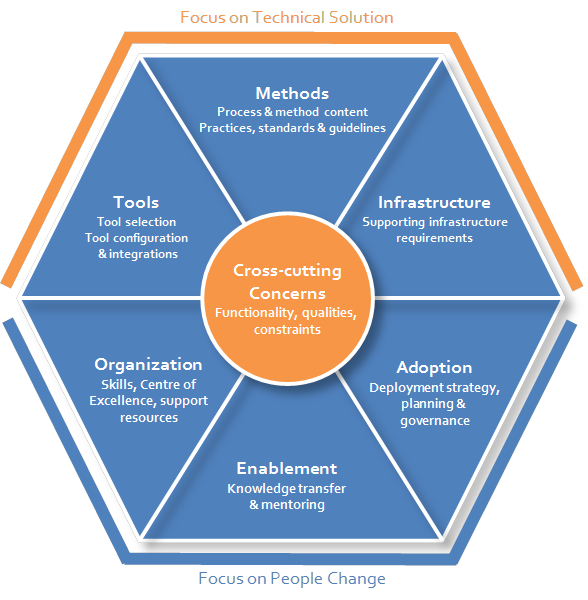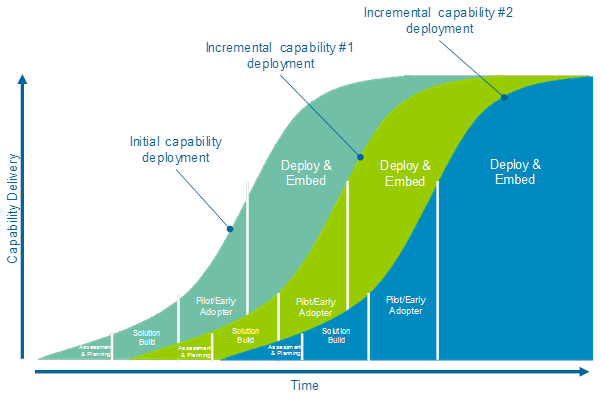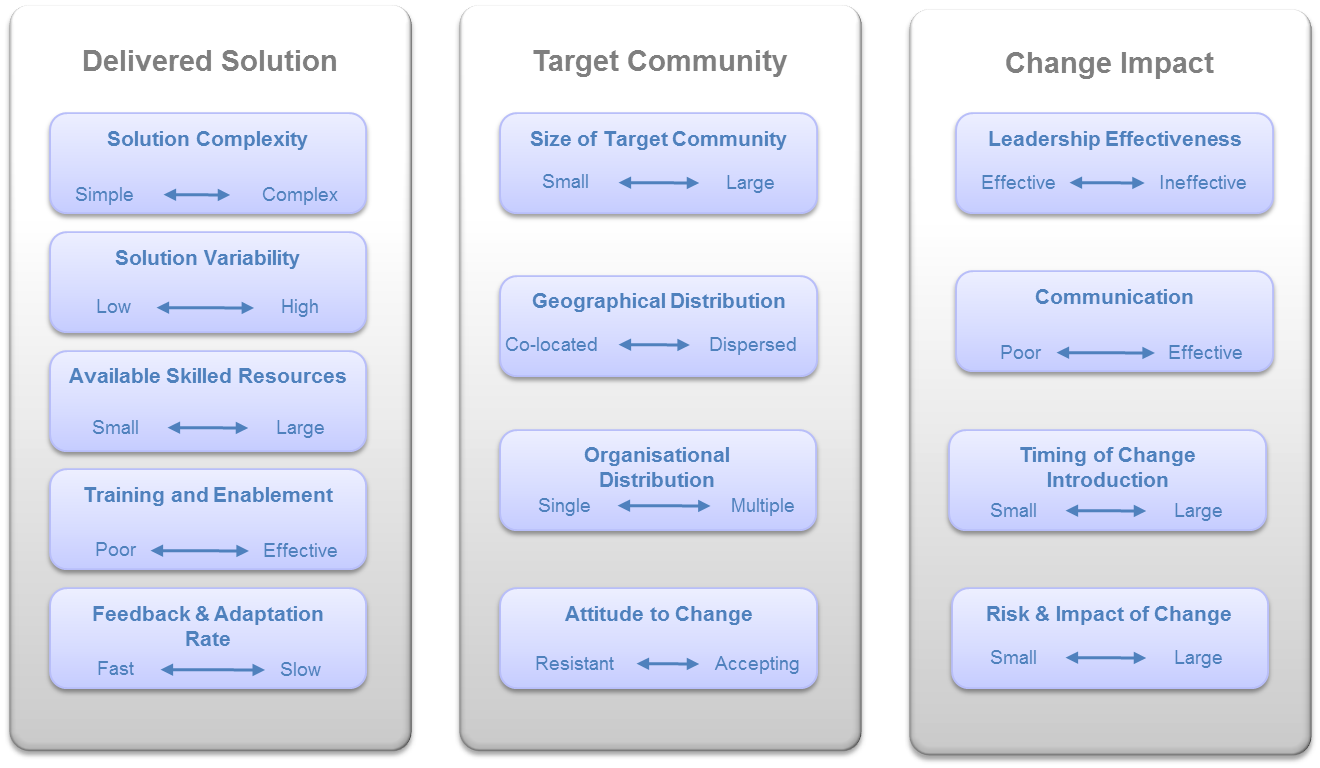Implementation planning and deployment roadmap
Authors: JohnDuckmantonBuild basis: The Rational solution for Collaborative Lifecycle Management (CLM) and the Rational solution for systems and software engineering (SSE)
Adopting new systems or software engineering tools and practices on a large scale is a significant technological and organizational challenge that requires an appropriate level of coordination, collaboration, and governance to be successful.
This article describes four best practices to ensure successful deployment and user adoption:
 The DEA addresses:
The DEA addresses:
 When planning your adoption roadmap, many factors can influence the adoption approach and the pace of the adoption effort. These are summarized below:
When planning your adoption roadmap, many factors can influence the adoption approach and the pace of the adoption effort. These are summarized below:
 It is important to consider each of these factors to determine if it applies to your adoption, what impact it might have, and the steps you can take to minimize that impact. For an analysis of these factors and some practical measures that can be taken to minimize them, see Accelerating adoption of software tools & practices.
It is important to consider each of these factors to determine if it applies to your adoption, what impact it might have, and the steps you can take to minimize that impact. For an analysis of these factors and some practical measures that can be taken to minimize them, see Accelerating adoption of software tools & practices.
- Address all aspects of the solution
- Build the right team
- Deploy capabilities, not tools
- Tackle larger deployments incrementally
Address all aspects of the solution
Deploying software into the enterprise is more complicated than just provisioning hardware and installing your software on it. There are many aspects that require careful consideration and planning to ensure that the software works correctly, performs as expected, integrates effectively with other systems, and supports your business processes. The software users must also receive the necessary training to know how to use it effectively. The IBM Rational Development Environment Architecture (DEA) is a framework that you can use to address all aspects of deployment of new tools, working practices, or both. The DEA addresses:
The DEA addresses:
- The processes or working practices to be adopted or incorporated into the tools (method)
- The tools to be deployed and their integrations to other systems
- Enablement in methods and tools
- The infrastructure required to support methods, tools and enablement
- Organization (to use and support methods, tools, enablement and infrastructure)
- The plan for adoption of the above elements
Method
A key element of any development environment is the method that is followed, whether formally or informally, by practitioners. A method defines project roles, tasks, work products, and processes. It is also underpinned by guidelines, standards, templates, and examples that can be applied on a project.Tools
Development tooling automates aspects of the method being followed. For example, you might use a tool for storing and managing requirements on the project, or use a tool for visually modeling architectures and designs, or use particular tools for testing software, and so on.Enablement
Enablement (training and mentoring) of practitioners in the use of the development environment contributes to its successful adoption. Therefore, an aspect of a development environment is the definition and creation of training and mentoring materials that can be applied. The enablement itself is focused on the use of the method and tools within the environment.Infrastructure
Method, tools, and enablement are supported by some infrastructure (hardware and software). For example, you might want to web-enable the method, and then deploy it on the company intranet, which would require a web server and some hardware on which to run it. Development tools are often run on practitioner workstations with an appropriate specification in terms of CPU, memory, and disk. Training materials can be made available via several mechanisms, over and above classroom training -- for example, web-based training would require the presence of a web server and associated hardware.Organization
The right organization is critical to support the use of a development environment. This might include providing specialists in certain aspects of the environment (such as method experts, tool specialists, trainers, and mentors), personnel to administer and support the environment, and personnel to augment the existing set of skills available through the company help desk. In addition to the environment itself, which requires people, there is clearly a need to create (develop) the development environment, which also requires people, including the development environment architect.Adoption
Adoption addresses the process of putting all of the above elements in place in an organized way and ensuring that the benefits expected from the development environment are being achieved. This is more than simply acquiring the relevant hardware and software, installing and configuring the environment, and training and mentoring end users. Adoption is equally concerned with the migration of existing assets, such as work products residing in a now-legacy tool set, and the collection of measurements that allow the development environment to be assessed against desired results. It is important to recognize that this adoption represents a change in the organization and needs to be managed as such.Cross-cutting elements
There are, of course, elements that cut across the areas described above, and they represent functionality, qualities, or constraints. The functionality provided by a development environment represents a particular software engineering discipline, such as testing. A quality represents a property that is exhibited by the development environment, such as the ability for the development environment to scale to support different numbers of concurrent users. A constraint represents a restriction on the options that are available for implementing the development environment, such as the need to accommodate a particular operating system. For more information about the IBM Rational Development Environment see The rise of the Development Environment Architect on IBM developerWorks.Build the right team
Adopting new software or systems engineering tools and practices on a large scale is a significant technological and organizational challenge that requires an appropriate level of coordination, collaboration, and governance in order to be successful. It will also impact, directly and indirectly, a large number of people within the organization. These key user groups are instrumental in the success of the adoption effort: Executive sponsorship Change will happen more smoothly with effective leadership. When the vision, goals, and benefits are effectively communicated and understood, and the adoption is correctly planned and managed, people will naturally align the work that they do toward achieving those goals. Achieving executive-level support for the change initiative within the target organization is therefore critical. Solution deployment team Key to the success of any large-scale deployment is the deployment team itself. Typically, this will be comprised of personnel in these roles:- Project management – Personnel who are focused on planning and organization, day-to-day management, and status reporting for the deployment.
- Solution architecture – One or more personnel who are focused on defining the overall solution technical architecture and providing architectural governance during the deployment.
- Domain and product subject matter experts – Personnel with specialist knowledge in one of more of the domains affected; for example, requirements management; or specialists in particular aspects of the tooling solution. It is important to focus on identifying and growing these skills early during the deployment.
- Trainers, coaches, and mentors – Internal personnel or external consultants with the skills and experience required to build the expertise of the SMEs initially, and support training and mentoring activities during the adoption.
- External consultants – For example, experts from tool vendor organizations, management, or process consultants.
Deploy capabilities, not tools
Organizations adopting IBM Rational products are typically not just looking to install new tools, but are looking to them to provide one or more capabilities, such as requirements management, source control, and performance testing. Sometimes, the organization might already have the capability and is looking to better tools or practices to help them to increase their effectiveness. Many IBM Rational tools support more than one capability. Therefore, it is important when deploying a new solution to understand what capabilities you want to deploy. Doing this will help you focus on the short-term goals of the deployment, the scope of any tool configuration, the impact on any existing methods or practices, and the associated enablement needs. It will also help you ensure that you deliver something of value to stakeholders. When you are deploying the solution to a large number of users, a capability-based deployment can also provide a means to organize incremental delivery of functionality in discrete manageable chucks (See below).Tackle larger deployments incrementally
Deploying a new tooling solution can be a significant change effort within an organization. Therefore, you must keep in mind that an organization can effectively support only a given size of change effort. There are many underlying reasons for this, including these reasons:- The time lag between initial purchase and realization of the benefit might be too large leading to loss of management focus
- The disruptive impact of the transition to new tools and working practices will become too great and will impact on core business activities
- The organization will have a limited capacity to enable and support new users
- Carefully identifying the right capability to include in each increment, ensuring that practices and associated tooling are delivered together
- The value and priority of each increment to the stakeholders
- The implications of not having all the expected new capability at once. Often this can lead to temporary workarounds or duplication of effort. This needs careful communication in order not to impact on morale and expectations.
- Assessment & planning – Where the activities to be performed in the current wave are identified and planned
- Solution build – The infrastructure is established, the tools are installed and configured, and supporting materials, such as training and mentoring materials, are created.
- Pilot and/or early adoption – The solution is trialed with a small number of users in order to validate the technical solution and the readiness of the deployment team and gain feedback.
- Large-scale deployment & embedding – The capability is gradually rolled out to the entire user community
 When planning your adoption roadmap, many factors can influence the adoption approach and the pace of the adoption effort. These are summarized below:
When planning your adoption roadmap, many factors can influence the adoption approach and the pace of the adoption effort. These are summarized below:
 It is important to consider each of these factors to determine if it applies to your adoption, what impact it might have, and the steps you can take to minimize that impact. For an analysis of these factors and some practical measures that can be taken to minimize them, see Accelerating adoption of software tools & practices.
It is important to consider each of these factors to determine if it applies to your adoption, what impact it might have, and the steps you can take to minimize that impact. For an analysis of these factors and some practical measures that can be taken to minimize them, see Accelerating adoption of software tools & practices.
Related topics: None
External links:
Additional contributors: PeterEeles (Development Environment Architecture)
Contributions are governed by our Terms of Use. Please read the following disclaimer.
Dashboards and work items are no longer publicly available, so some links may be invalid. We now provide similar information through other means. Learn more here.